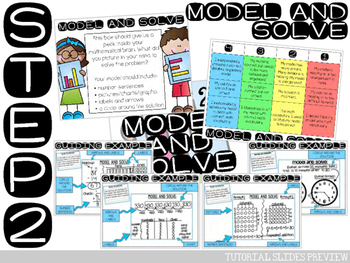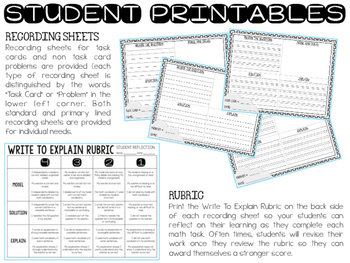Write To Explain How To Guide: Creating Word Problem Models and Explanations
- Zip
What educators are saying
Description
Are your students struggling to explain their math reasoning? Are your young mathematicians creating confusing or vague math models?
This Write To Explain How To Guide will walk your students through five steps for creating detailed math model and explanations. Guiding examples and rubrics are provided for each step. This guide is designed for use with any math problem requiring modeling and explanation.
THE WRITE TO EXPLAIN PROCESS
Step 1 : Record the Question
Step 2: Model and Solve
Step 3: Record the Solution
Step 4: Explain Your Thinking
Step 5: Reflect on Your Learning
Consistently using these five steps when solving complex math problems will help your students develop the ability to independently create organized math models and communicate their math reasoning clearly and concisely.
***************************************************************************
THREE HOW TO GUIDE FORMATS
Projectable Slides: Display these slides as you teach your students about the five steps for creating detailed math models and explanations.
Printable Binder: Print these slides and store them in a binder to create a step-by-step Write To Explain Guide. As your students work to explain their math reasoning, their printed guide will walk them through each detail of the Write To Explain process as they become confident, independent masters.
**Color and black line master formats included.**
iPad/Tablet Guide: Upload the iPad/Tablet Ready PDF to your library or Google Drive so students can access the step-by-step Write To Explain Guide digitally. Exactly like the printed guide, this digital guide will walk your students through each detail of the Write To Explain process.
***************************************************************************
OTHER PRINTABLES INCLUDED
Recording Sheets
Recording sheets for task cards and non task card problems are provided (each type of recording sheet is distinguished by the words “Task Card” or “Problem” in the lower left corner. Both standard and primary lined recording sheets are provided for individual needs.
Student Rubric
Print the Write To Explain Rubric on the back side of each recording sheet so your students can reflect on their learning as they complete each math task. Often times, students will revise their work once they review the rubric so they can award themselves a stronger score.
Teacher Rubric
Meaningful feedback can greatly enhance student learning, growth, and achievement. The teacher rubric is designed to help you give your students timely feedback that is meaningful and specific. It is almost identical to the Student Reflection rubric except for a change in pronouns. This rubric can be used to give formative feedback or as a summative assessment tool.
***************************************************************************
If you are looking for a strong collection of rigorous math problems that require models and explanations, check out my Write To Explain Task Card Decks.
***************************************************************************
CUSTOMER TIPS
How to get TPT credit to use on future purchases:
• Please go to your My Purchases page (you may need to login). Beside each purchase you'll see a Provide Feedback button. Simply click it and you will be taken to a page where you can give a quick rating and leave a short comment for the product. I value your feedback greatly as it helps me determine which products are most valuable for your classroom so I can create more for you. ☺
Be the first to know about my new discounts, freebies and product launches:
• Look for the red star near the top of any page within my store and click it to become a follower. Voila! You will now receive customized email updates about this store. ☺





